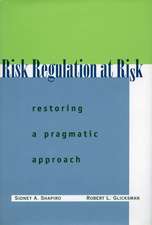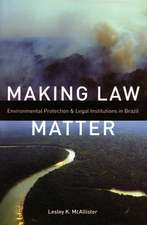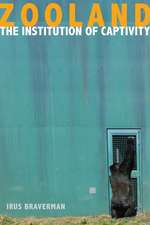Wild Life: The Institution of Nature
Autor Irus Bravermanen Limba Engleză Hardback – 21 apr 2015
Wild Life begins with the plight of a tiny endangered snail, and ends with the rehabilitation of an entire island. Interwoven between its pages are stories about golden lion tamarins in Brazil, black-footed ferrets in the American Plains, Sumatran rhinos in Indonesia, Tasmanian devils in Australia, and many more creatures both human and nonhuman. Braverman draws on interviews with more than one hundred and twenty conservation biologists, zoologists, zoo professionals, government officials, and wildlife managers to explore the various perspectives on in situ and ex situ conservation and the blurring of the lines between them.
| Toate formatele și edițiile | Preț | Express |
|---|---|---|
| Paperback (1) | 175.78 lei 3-5 săpt. | |
| Stanford University Press – 5 apr 2015 | 175.78 lei 3-5 săpt. | |
| Hardback (1) | 649.11 lei 6-8 săpt. | |
| Stanford University Press – 21 apr 2015 | 649.11 lei 6-8 săpt. |
Preț: 649.11 lei
Preț vechi: 801.37 lei
-19% Nou
124.20€ • 129.69$ • 102.56£
Carte tipărită la comandă
Livrare economică 15-29 aprilie
Specificații
ISBN-10: 0804793220
Pagini: 344
Dimensiuni: 152 x 229 x 25 mm
Greutate: 0.59 kg
Editura: Stanford University Press
Colecția Stanford University Press
Recenzii
"Wild Life is a must-read, especially for young people growing up in a world where all of nature is managed and the divides between in situ and ex situ have disappeared. Braverman interviews a wide array of conservationists and tells real life stories of species on the brink of extinction, making a unique contribution to conservation and to how we think about nature."—Alexander J. Travis, Atkinson Center for a Sustainable Future, Cornell University
"This is a most thoughtful and well-written book about the difficulty of separating ideas about the lives of nonhuman animals (animals) who are held 'captive' and animals who are considered to be 'wild.' While there are clear distinctions, for example, between an elephant who is held captive in a cage in a zoo and shipped around here and there as a mating machine, and an elephant who is free to move around in large wild areas, even those who are fenced, the latter individuals still are captive but to a lesser degree than their caged relatives. Many other examples make the case that 'wild' does not mean 'free.' I highly recommend this book for those who want a good picture of the complexities of distinguishing between wild and captive and also what the word 'nature' means in an epoch called the 'anthropocene.' There's a smorgasboard of opinions, each of which needs to be openly discussed, as we move into unprecedented times of increased human domination of our magnificent planet - earth, air, and water. We're here, there, and everywhere, and it isn't getting better. Excellent for advanced undergraduate and graduate courses."—Marc Bekoff, Professor Emeritus of Ecology and Evolutionary Biology at the University of Colorado, Boulder
"Braverman has written a book that challenges the reader's beliefs on every page, stimulates so much thought, and creates so many "aha!" moments that I wished it was twice as long. . . . It is a book that anyone who is interested in the direction that our world is taking should read. It is a book that anyone interested in conservation should have, that anyone who has a bumper sticker that says 'Save the (fill in species)' or is a member of a conservation organization should use to understand the complexities of our attempts for these species' salvation. Through Wild Life, Irus Braverman excellently traces the shapes of the debates and brings to light a side of conservation that needs to be understood. In a very real way, the fate of so many lives on our planet hinges on these issues."—Todd Simmons, Silive
"Wild Life: The Institution of Nature is the second book by Irus Braverman dealing with the topic of zoos, following the highly acclaimed 2012 publication of Zooland: The Institution of Captivity. In short, both books are mustreads for anyone in our profession, with the author showing increasing understanding of and appreciation for our community . . . Wild Life is the quintessential popular scientific book about the One Plan approach to species conservation."—Markus Gussett, WAZA News
"Should the goal of conservation efforts be the preservation of endangered species in their natural state, in an environment free of human intervention? Or is it legitimate to conserve vanishing animals in captivity—ex situ—even if this means that some species will depend entirely on the kindness of zookeepers for their continued survival? Examining this issue in fine detail, Irus Braverman posed this question to more than 120 biologists, zoo professionals, government offici
Notă biografică
Cuprins
Chapter 1 discusses the institution of the divide between in situ and ex situ and traces the administrative, disciplinary, regulatory, and historical perspectives of this divide. A collage of narratives by numerous conservationists demonstrates how the in situ and ex situ terminology has shaped their thinking and everyday practices. The chapter also dedicates considerable attention to the meaning of nature, both in its manifestation as wilderness and in the context of the recent debate over the Anthropocene. Throughout, this chapter highlights the deep commitment and simultaneous ambivalence toward the idea of wild nature on the part of conservationists, who oscillate between eroding the in situ - ex situ dichotomy and fortifying it.
Chapter 2 opens with the story of Marius, the giraffe killed by the Copenhagen Zoo for being "surplus" to the genetically managed ex situ population of his subspecies. The chapter traces the evolution of the zoo into the quintessential site of ex situ conservation, a capacity that is most pronounced in the depiction of zoos as Noah's arks or as "insurance" populations. This chapter highlights the ethical dilemmas that conservationists confront upon deciding if and when to transfer the last surviving members of imperiled species into captivity, and the divergence between the focus on individual animals by animal rights activists and the species-oriented focus by conservationists. Finally, the chapter discusses those species and individuals who are captive-for-life¿for whom the captive facilities are the only viable habitat. Such situations not only question the traditional in situ ¿ ex situ distinctions, but also the nature of ex situ itself.
Chapter 3 documents how conservation is currently morphing into a continuum between the two poles of in situ and ex situ. From the endless combinations of in situ and ex situ, the chapter briefly describes seven inter situ nodes: genebanks, zoo breeding centers, conservation farms, conservation hatcheries, protected areas, wildlife refuges, and national parks. The chapter starts with the node perceived by many of my interviewees as closest to the ex sitüor captive¿pole, and gradually moves along the continuum toward what is generally perceived as closest to the in sitüor wilderness¿pole. While documenting the continuum approach in species conservation, this chapter simultaneously challenges the continuum's linear and prefixed constructions. Throughout, the chapter points to the inherent messiness and fluidity between and within the sites. While the practitioners who perform this work are fully aware of this messiness, their conceptual framework often lags far behind.
Because of the complexities and sensitivities of the interrelations between in situ and ex situ, the movement between the various nodes on the continuum has become its own site of management. Chapter 4 focuses on the primary mode of movement from captivity into the wild¿reintroductions¿and on the "soft law" that regulates them. A discussion of the reintroductions of the Schaus swallowtail butterfly and the eastern hellbender serves to demonstrate some of the difficulties that ensue when animals are physically transferred between captive and wild settings, and some of the strategies taken up by conservationists to deal with such difficulties.
Chapter 5 centers on the U.S. Endangered Species Act (ESA) of 1973. This focus serves the book's broader goal of exploring the powers and the limits of legal devices for regulating conservation, and their reinforcement and negotiations of the in situ ¿ ex situ divide. The chapter shows how this divide still matters for administrators who assess, count, or discount animal bodies for listing and recovery. It discusses four legal strategies through which ESA norms and related practices distinguish captive from wild: the definition of "take," the designation of non-essential experimental populations, hybridization policies, and split listing practices. The chapter also illustrates the critical importance of categorizing animal bodies as existing either in situ or ex situ for assigning them with legal protections, as well as the negotiations that take place within this regulatory sphere to account for the fluidity and variation of conservation practices.
Chapter 6 turns to focus on databases and population management. The chapter demonstrates how the two distinct in situ and ex situ models increasingly bleed into one another and how certain computer models for population management potentially enable the integration of the previously separate in situ and ex situ models. The science of small population management that has emerged to address the fragmentation and low numbers of animal populations in both zoos and the wild provides the scientific language for bridging between the previously disparate management models. CBSG's One Plan approach in particular translates the geographic and genetic fragmentation of populations, and the alienation between their managers, into integrative networks. Although the rhetorical distinction between in situ and ex situ conservation is far from dead, the interconnections between these two conservation poles through approaches such as the One Plan are increasingly realized in practice.
Wild Life concludes with the story of Rotoroa Island in New Zealand, demonstrating the emerging understanding among certain conservationists that nature may need to be managed in perpetuity. This understanding raises urgent questions about nature's definition, the definition of conservation, and the role that managing both nonhumans and humans should play in the conservation of natures.
Partula snails, Puerto Rican crested toads, Rio Grande silvery minnows, and dusky seaside sparrows are but a few species stories reflected upon in the introduction. Each story reveals one aspect in the complex interrelations between wild and captive management. As the stories show, government agencies, field experts, zoo administrators, and population managers are only a fraction of the massive, behind-the-scenes international network of knowledge, genetic material, and real animals that comprise global conservation today, all entangled in messy efforts to battle extinction and save life. The stories also present in vivid detail the attempts by conservationists to integrate the previously insular and bifurcated conservation systems: conservation "in" and "outside" the wild (in situ and ex situ). And while these stories all focus on life and survival, they are inevitably also about death and extinction.















